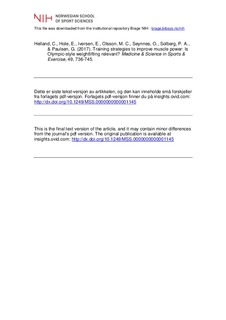| dc.description.abstract | Introduction: This efficacy study investigated the effects of 1) Olympic-style weightlifting (OWL), 2) motorized strength and power training (MSPT), and 3) free weight strength and power training (FSPT) on muscle power. Methods: Thirty-nine young athletes (20 T 3 yr; ice hockey, volleyball, and badminton) were randomized into the three training groups. All groups participated in two to three sessions per week for 8 wk. The MSPT and FSPT groups trained using squats (two legs and single leg) with high force and high power, whereas the OWL group trained using clean and snatch exercises. MSPT was conducted as slow-speed isokinetic strength training and isotonic power training with augmented eccentric load, controlled by a computerized robotic engine system. FSPT used free weights. The training volume (sum of repetitions kg) was similar between all three groups. Vertical jumping capabilities were assessed by countermovement jump (CMJ), squat jump (SJ), drop jump (DJ), and loaded CMJ (10–80 kg). Sprinting capacity was assessed in a 30-m sprint. Secondary variables were squat one-repetition maximum (1RM), body composition, quadriceps thickness, and architecture. Results: OWL resulted in trivial improvements and inferior gains compared with FSPT and MSPT for CMJ, SJ, DJ, and 1RM. MSPT demonstrated small but robust effects on SJ, DJ, loaded CMJ, and 1RM (3%–13%). MSPT was superior to FSPT in improving 30-m sprint performance. FSPT and MSPT, but not OWL, demonstrated increased thickness in the vastus lateralis and rectus femoris (4%–7%). Conclusions: MSPT was time-efficient and equally or more effective than FSPT training in improving vertical jumping and sprinting performance. OWL was generally ineffective and inferior to the two other interventions | nb_NO |
